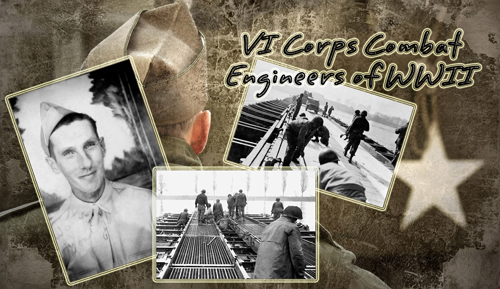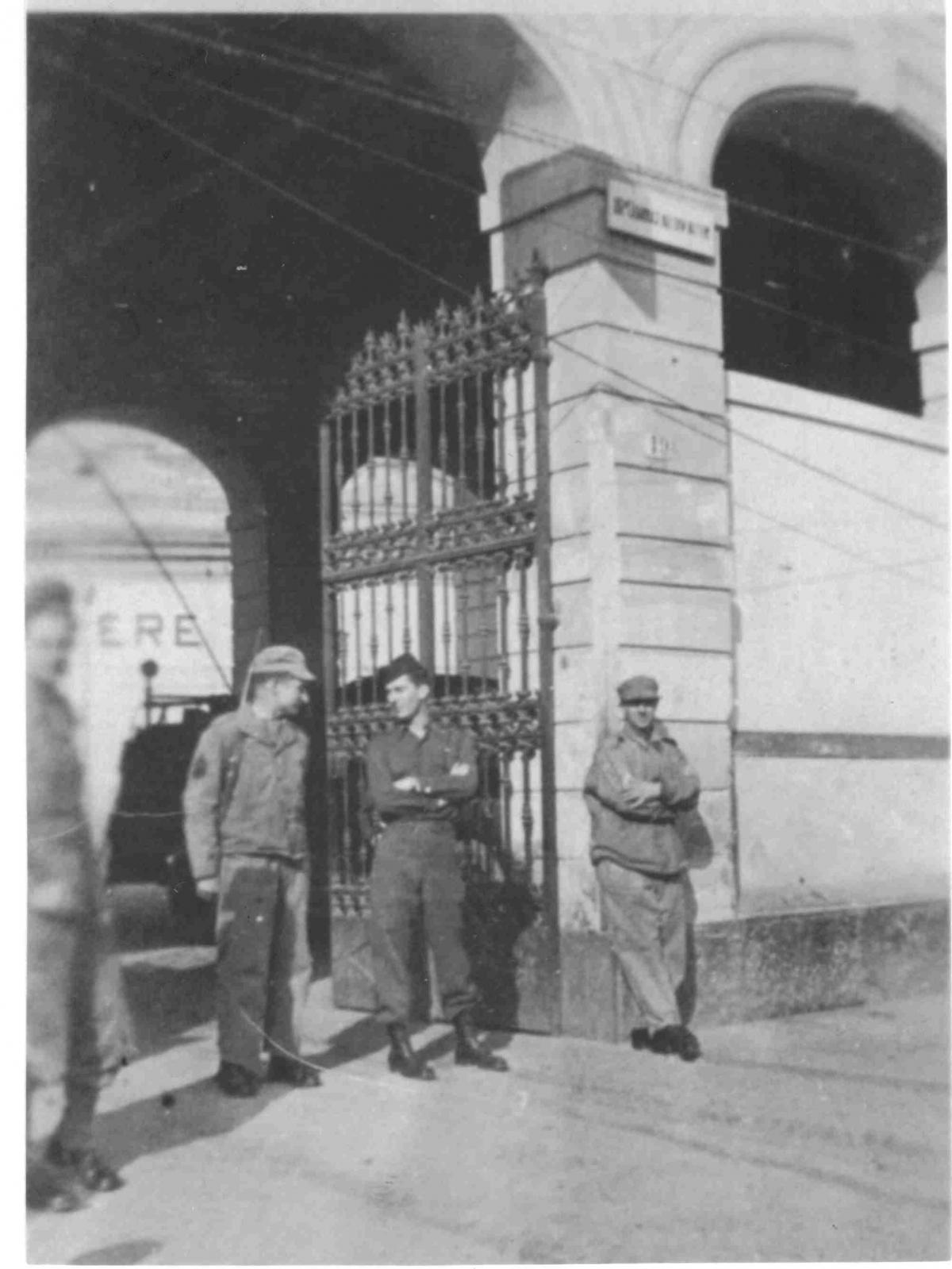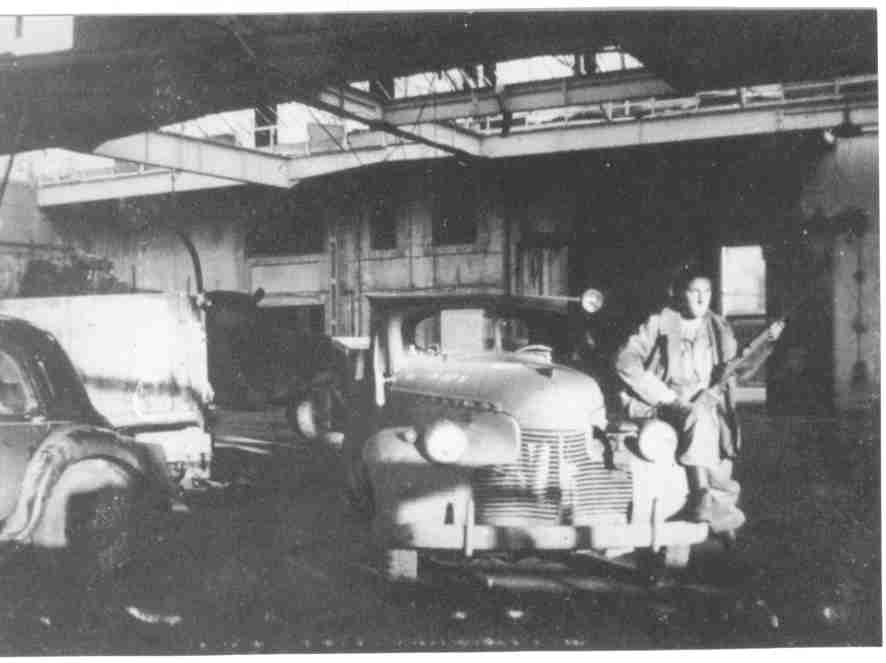The document we posted on the main page, "Engineer History, 5th Army, Mediterranean Theater" has several mentions of the Engineer Firefighting Platoons in Italy Jim may be interested in.
APPENDIX H
HISTORY OF FIFTH ARMY ENGINEER UNITS
1202nd and 1204th Engineer Composite Platoons
On 31 August 1942, several Engineer Fire Fighting Detachments -were activated at Camp Claiborne,
Louisiana. Basic training was completed, and Detachments #2 and #4 received special training at the
New Orleans Staging Area, Camp Harahan, Louisiana. This training was completed in March 1943 and the
u n i t s moved to Fort Dix, New Jersey. Detachment #4 l e f t the United States on April Fool's Day, a r r i v ing
a t Casablanca on 12 April. It was assigned to the Atlantic Base Section and operated an Army Fire
Station there u n t i l August. On 25 August, the unit was reorganized under the new Table of Organization
and Equipment 5-337, dated 12 May 1943, and redeaignatod the 1204th Engineer Fire Fighting Platoon. The
1204th was assigned to the Fifth Army on 19 August 1943 and l e f t Casablanca on the l a s t of the month
September was spent in a bivouac area at Blzerte and aboard ship enroute to Italy.
Detachment #2 l e f t the States one day l a t e r than i t s brother organization and landed at Oran.
This unit set up and operated f i r e stations at Oran, Jfers-El-Kebir, Tlemcen, Nemours and OuJda while
assigned to Mediterranean Base Section. Detachment #2 was also reorganized (16 August 1943) and r e designated
the 1202nd Engineer .Fire Fighting Platoon.. Four days l a t e r , the unit was assigned to the
Fifth Army.
1206th Engineer Composite Platoon
The 1206th Engineer Composite Platoon was organized as the Engineer Fire Fighting Detachment #6 on
31 August 1942 a t Camp Claiborne, at the same time Detachments #2 and #4 were formed. Training in fire
fighting was received at Camp Harahan, Louisiaoa, before the unit sailed to Oran. After the platoon
landed on 11 May 1943, i t was discovered that i t s equipment had been sent to Algiers, and i t was not r e covered
u n t i l 12 June, a month l a t e r . Many types of fires were encountered and extinguished during the
African campaign, the biggest problem, being water supply for the f i r e trucks.
On 25 July 1943, the unit was ordered to Sicily with the Seventh Army and l e f t Bizerte, North
Africa, on 25 July, landing at Licata on 9 August 1943. Again the problem was water supply, but the
u n i t , redesignated on 9 August 1943, as the 1206th Engineer Fire Fighting Platoon, finally got enough
wa-ter tankers to continue extinguishing f i r e s . It was becoming increasingly evident that something must
be developed to a s s i s t the f i r e fighters in combatting ammunition dump f i r e s . On 15 November 1943, the
unit was ordered to Naples via the Messina Tervy. The 1206th was assigned to Peninsular Ba3e Section
and worked i n Naples u n t i l 9 February 1944, when i t was attached to Fifth Array and ordered to Anzio.
1980th and 1981st Engineer Fire Fighting Platoons (Aviation)
The 1980th and 1981st Engineer Fire Fighting Platoons (Aviation) were activated at Bradley Field,
Connecticut, on 9 April 1943. The platoons consisted of one officer and twenty-nine enlisted men. The
a-nlisted men were drawn, for the most part, from the Airborne troops stationed at Bradley Field, with a
Small percentage of men with f i r e fighting experience scattered among the units.
After the u n i t s ' organization, civilian firemen conducted a five-week training course in the fundamentals
of combatting f i r e s . When training was completed, the 1980th was alerted for overseas movement,
and on 10 June 1943 sailed from the New York Port of Embarkation. The platoon arrived in North Africa
on 21 June 1943 and bivouacked a t La Senia, where i t 3pent six weeks gathering i t s equipment from a ll
p a r t s of North Africa. The unit was assigned to the Eastern Base Section on 3 August and went to
Bizerte for duty.
On 18 January 1944, while the unit was s t i l l in Bizerte, i t was reorganized and assumed the present
designation of 1980th Engineer Composite Platoon. The platoon gained much experience in Bizerte combatting
all types of fires, which helped prepare i t for the more hazardous duties which were to follow
In Italy. The unit boarded an LST on 23 March 1944, bound for Naples, and arrived there on 26 March.
The 1981st Fire Fighting Platoon went to Corsica after North Africa, where i t operated stations at
Cervioue Mezzavia, Porto Vecchio and AJaccio. On 10 March 1945, the unit was reorganized and redeaig•
aabed th.e 1981st Engineer Aviation Fire Fighting Platoon. Four days later, i t was assigned to Fifth
Army and embarked from the port of Ba3*la, Corsica, arriving at Leghorn, Italy, the same day.
-13-
------------------------------------------
SECTION IV
THE ANZIO BEACHHEAD
pages 101 & 102
12O6th Engineer Fire Fighting Platoon
The 1206th Engineer Fire Fighting Platoon was attached to Fifth Army from Peninsular Base Section and
on 9 February 1944 tunder the command of 1st Lieutenant Charles M. King, was ordered by the Fifth Army Fire
Marshal to proceed by water to the Anzio Beachhead. The unit left Naples the next day and arrived at Anzio
on 12 February. The problems of firefighting on the beachhead were numerous, due to the blackout, smoke
enemy artillery, bombing and strafing. The dominating problem, as usual, was the supply of water.
It was on the beachhead on 18 March, that the first tankdozer (tank with dozer blade) appeared for use
against ammunition dump fires. The first machine was borrowed from the l6th Engineers and was an M-4 tank
with a hydraulically operated blade. By the last of March, five tankdozers had been sent to ammunition
dumps located on the beachhead— some of these tankdozers were cable operated.
Tests proved that the largest blades were best for ammunition fires. Also, it was found that rubber
treads burned very easily, and that tankdozers used on ammunition fires needed all-steel tracks. They
also needed curtains, because shell cases worked their way into the track between the bogies and invariably
the machines threw a track when attempting to turn.
All types of fires were encountered on the beachhead by the 1206th, including civilian homes, ammunition
dumps, gasoline dumps, ration dumps (everyone was anxiously awaiting a fire call from the PX
warehouse, which fortunately never came), Allied Military Government medical dump. Chemical Warfare Service
dump, Signal Corps dumps, the M^th Division Command Post, and once the Fifth Army Advance Command Post,
The unit combatted fires on ships in the harbor, filled and sunk barges, pumped out drydocks, cleaned
sewer systems, filled water tanks. On several occasions, the assistance of the Navy was requested to supply
an LCT for use as a trailer pump in order to combat a fire on the shore line which was inaccessable
to vehicles. There were many motor pool blazes and a large number of DUKW fires. Minefields were always
a hazard to the fire fighters, and on several occasions it was noted by men of the unit that civilians
stepped on mines in areas the fire fighters have just left.
- 101
SECTION IV
1206th Engineer Fire Fighting Platoon (cont`d).
Aircraft fires were also handled by the 1206th. As artillery shells do not always respect the Red Cross symbol,
hospitals were given particular attention. In one case, a trailer pump was installed between the
38th and 93rd Evacuation Hospitals, and a line stretched to both for immediate use by trained
personnel before the arrival of the Fire Department apparatus.
During the beachhead operations, the platoon suffered 8 casualties, including the death of Lieutenant
King, who was temporarily replaced by Lieutenant Small of the 1980th Engineers. After the breakthrough
of the forces was effected, the 1206th Platoon remained in the Anzio area to protect the remaining
dumps until relieved by a Peninsular Base Section unit.
-------------------------------------------------------------------------------------------
SECTION VI
MAY 11TH TO THE ARNO
page 216
1981st Engineer Aviation Fire Fighting Platoon
On 14 March 1945, the 1981st Engineer Aviation Fire Fighting Platoon, commanded by 1st Lieutenant
Lawrence H. Dykers, arrived at Leghorn from Corsica. The following day, the platoon went into service
at Pistoia, relieving the 1206th Engineers. During March, the organization had fourteen fire calls. On
20 torch, tv/o fire trucks from the 1981st were sent to the 703rd Engineer Petroleum Distributing Company
in answer to a call to extinguish a large fire which resulted from a break in the Pontedera - Pistoia
pipe line. Burning gasoline flooded a ditch along the railroad tracks for one hundred yards. Fire had
broken out while crews were repairing the pipe line. Three sections fought this fire for one and a half
hours.
-------------------------------------------------------
SECTION Yl
1206th Engineer Composite Section
As September began. Section I of the 1206th Engineer Composite Platoon was at Cecilia, Section II at
Panzane, and Section III at Peccioli. The sections remained at these locations most of the month.
Section III was the first to move. On 16 September, it went to Staffoli, north of Pontechra. On 28
September, both Section I and Section II moved to Lucca, Section I was sent to Lido di Caraaiore on
Ik October, then after three days moved again, this time to Lucca to join the rest of the platoon.
Most of the fires during this time were quickly extinguished, only one ammunition dump fire causing
any particular trouble. The station remained in Lucca until 19 November, when it vas moved east to
Pistoia. On the 26th of November the 1206th Engineer Composite Platoon wa.s redesignated the 1206th
Engineer Composite Section.
The unit was attached to the Il68th Engineer Group on 29 December 1944. It moved to Montecatini on
15 March. Pour days later, the unit was again redesignated, this time as the 1206th Engineer Service
Detachment, a designation that was to last only a few weeks, until the first day of the new attachment
on 5 April.
SECTION VI
1980th Engineer Composite Section
After the fall of Florence, Section I of the 1980th Engineer Composite Platoon under the command of
1st Lieutenant Melvyn E. Small moved to Campi on 12 September. Italian houses and wheat shocks were the
only fires the section was called to in this sector. On U. September, Headquarters Section moved to
Sesto to protect the Army installations in the Florence area. Most fires here were at the airport or at
civilian homes. Daily preventative inspections were made at all the nearby installations.
One unusual fire occurred at the Quartermaster Gasoline Dump. Eighty octane gasoline leaked from
the pipe line into a creek. Civilians proceeded to salvage this gas by scooping it up. When 300 gallons
had leaked out, fire broke out so rapidly that there were twenty casualties, eleven of which had to be
hospitalized, and one died on the scene.
1980TH
Section I moved from Campi to Scarperia on 29 September. Four days after the station was opened,
the area was subject to a heavy bombing and strafing attack by the enemy. As a result, a fire started
in an ammunition dump nearby. The firemea were strafed enroute to the fire, but escaped uninjured.
Vehicles blocked the road because of the strafing, greatly hampering the fire apparatus movement.
A call was sent to Sesto for help, but that section was combatting a fire at the 82nd Ordnance Command
Post. The Scarperia section extinguished the ammunition fire alone, as the Sesto equipment arrived
late] The loss was held to thirty tons of black powder and one ton of TNT. This was considered quite
minor as there was several thousand tons of ammunition in this dump.
On 12 October, a fire station was opened at Pietramala on Highway #65. This station, the most advanced
operated by the 1980th Platoon, had several minor fires caused by enemy shell fire and strafingall
of which were quickly extinguished, losses being held to a minimum. On 10 November, in order to
cover more completely the extended forward area,'another station was opened at Villanova on Highway #65,
- 215
SECTION VI
1980th Engineer Composite Section (cont'd).
The unit was redesignated on 28 November from the 1980th Engineer Composite Platoon to the 1980th
Engineer Composite Section. The Fifth Army front had advanced to the point where another station was
needed. On 9 December, the station at Scarperia closed and a new station was established at Monghidoro
at Ammunition Supply Point 0-4-27. The section was attached to the 1168th Engineer Combat Group for
administration only on 27 December 1944.
The Villanova station was closed on 10 June and reopened at Venturina three days later. This latter
move proved to be only a temporary one and the station was closed on 21 January. The 1980th Engineer
Composite Section was again reorganized and redesignated the 1980th Engineer Aviation Fire Fighting Platoon,
a change which necessitated the Iocs of ten enlisted men who were transferred to a replacement
depot. No new moves were made until after the Po Valley campaign had begun.
------------------------------------------------------------------
1981st Engineer Aviation Fire Fighting Platoon
On 14 March 1945, the 1981st Engineer Aviation Fire Fighting Platoon, commanded by 1st Lieutenant
Lawrence H. Dykers, arrived at Leghorn from Corsica. The following day, the platoon went into service
at Pistoia, relieving the 1206th Engineers. During March, the organization had fourteen fire calls. On
20 torch, tv/o fire trucks from the 1981st were sent to the 703rd Engineer Petroleum Distributing Company
in answer to a call to extinguish a large fire which resulted from a break in the Pontedera - Pistoia
pipe line. Burning gasoline flooded a ditch along the railroad tracks for one hundred yards. Fire had
broken out while crews were repairing the pipe line. Three sections fought this fire for one and a half
hours.
-------------------------------------------------------
SUCTION VI
B r i t i s h Army Tire Service
Included with British troops taken over by the Fifth Army when i t assumed command of the Florence
area was the 17th First Class Fire Brigade of 101st Fire Fighting Company. At the beginning of 191+5,
however, when the Eighth Army commitments grew, t h i s brigade was relieved by the 606th F i r s t Class Fire
Brigade of 152nd Fire Fighting Company. About this time, i t was decided by Allied Force Headquarters
that the f i r e risks of Fifth Army were greater than could be covered by the United States Fire Department,
and on 20 February a Staff Officer, Army Fire Service, was appointed to the B r i t i s h Increment of
Fifth Army to inspect and report. Liaison was effected with the Fifth Army F i r e Marshal, and very soon
the four brigades of the 152nd Fire Fighting Company together with Company Headquarters were operating
in the Fifth Army Area.
-------------------------------------------------------






